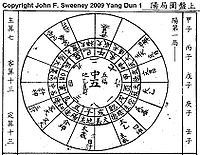
Tai Yi Shen Shu
Encyclopedia

Da Liu Ren
Da Liu Ren is a form of Chinese calendrical astrology dating from the later Warring States period.Along with the divination methods Qi Men Dun Jia 奇门遁甲 and Taiyi 太乙—collectively known as the "Three Styles" —Da Liu Ren is considered in China to be one of the highest forms of Chinese metaphysics.It...
and Qi Men Dun Jia
Qi Men Dun Jia
Qi Men Dun Jia is an ancient form of divination from China, which is still in use in China, Taiwan, Singapore and the Chinese diaspora in Southeast Asia...
.
These arts are basically involved in divination and to a certain extent astrology. The San Shi or Three Styles 三式 are considered China's highest metaphysical arts.
In general Da Liu Ren is considered the highest of the three arts and was most extensively used from the time of the Song Dynasty until the late Qing. Tai Yi Shen Shu is used to predict macroscopic events like wars or the meaning of supernovae. One form of Tai Yi Shen Shu has been popularized over the centuries to predict personal fortunes.
Genghis Khan
Genghis Khan
Genghis Khan , born Temujin and occasionally known by his temple name Taizu , was the founder and Great Khan of the Mongol Empire, which became the largest contiguous empire in history after his death....
, emperor of China, referred to Tai Yi at one point to decide whether or not his planned invasion of Japan would succeed. When the Tai Yi count indicated that invasion would prove unsuccessful, Khan decided not to invade Japan that year. Numerous similar examples abound in classical Chinese literature, especially among the dynastic histories.
Method:
The methodology is quite similar to the other arts with a rotating heavenly plate and fixed earthly plate. While the art makes use of the 8 trigrams as well as the 64 hexagrams as a foundation, analysis is conducted from the Tai Yi Cosmic Board and the array of symbols found thereon, with special reference to the position of symbols in specific palaces. Important symbols include the Calculator, the Scholar, Tai Yi and Tai Yi, for example.
A number of spirits rotate around the sixteen palaces of the Tai Yi cosmic board, of which there are 72 cosmic boards for the Yin Dun period of each year, and 72 cosmic boards for the Yang Dun period of the year. The spirits land in different palaces with each configuration of the cosmic board. Each cosmic board contains a number of "counts" or numbers - the Host Count and the Guest Count taking primary importance over the Fixed Count.
See also
- Feng ShuiFeng shuiFeng shui ' is a Chinese system of geomancy believed to use the laws of both Heaven and Earth to help one improve life by receiving positive qi. The original designation for the discipline is Kan Yu ....
- I ChingI ChingThe I Ching or "Yì Jīng" , also known as the Classic of Changes, Book of Changes and Zhouyi, is one of the oldest of the Chinese classic texts...
- Yijing
- Hexagrams
- Chinese AstrologyChinese astrologyChinese astrology is based on the traditional astronomy and calendars. The development of Chinese astrology is tied to that of astronomy, which came to flourish during the Han Dynasty ....
- Chinese AstronomyChinese AstronomyChinese Astronomy may refer to :* Chinese astronomy, the history of Chinese knowledge and scientific culture about astronomy.* Chinese Astronomy, a periodic scientific journal....
- Chinese Classical Texts
- Da Liu RenDa Liu RenDa Liu Ren is a form of Chinese calendrical astrology dating from the later Warring States period.Along with the divination methods Qi Men Dun Jia 奇门遁甲 and Taiyi 太乙—collectively known as the "Three Styles" —Da Liu Ren is considered in China to be one of the highest forms of Chinese metaphysics.It...
- Qi Men Dun JiaQi Men Dun JiaQi Men Dun Jia is an ancient form of divination from China, which is still in use in China, Taiwan, Singapore and the Chinese diaspora in Southeast Asia...
- Tie Ban Shen ShuTie ban shen shuTie Ban Shen Shu is an ancient form of divination from China, which is still in use in China, Taiwan, Singapore and the Chinese diaspora in Southeast Asia. Tie ban shen shu is regarded as among the most accurate and most difficult methods of personal fortune divination...
- Classical Chinese literature
- Siku QuanshuSiku QuanshuThe Siku Quanshu, variously translated as the Imperial Collection of Four, Emperor's Four Treasuries, Complete Library in Four Branches of Literature, or Complete Library of the Four Treasuries, is the largest collection of books in Chinese history and probably the most ambitious editorial...
Further reading
- "Chinese Mathematical Astrology" by Ho Peng Yoke
- "Tai Yi Divination" by Jack Sweeney*
- "Tai Yi 72 Yang Dun Situations" by Jack Sweeney
- "Tai Yi 72 Yin Dun Situations" by Jack Sweeney
External links
- [www.phoenixanddragonfengshui.com/index.asp] Tai Yi Shen Shu website of Jack Sweeney.

